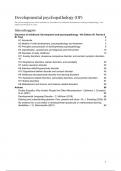Summary
Summary Disorders of childhood: Development and psychopathology - 4th Edition (R. Parritz & M. Troy)
- Course
- Institution
- Book
A summary of Disorders of childhood: Development and psychopathology - 4th Edition (R. Parritz & M. Troy). The concepts are underlined.
[Show more]



